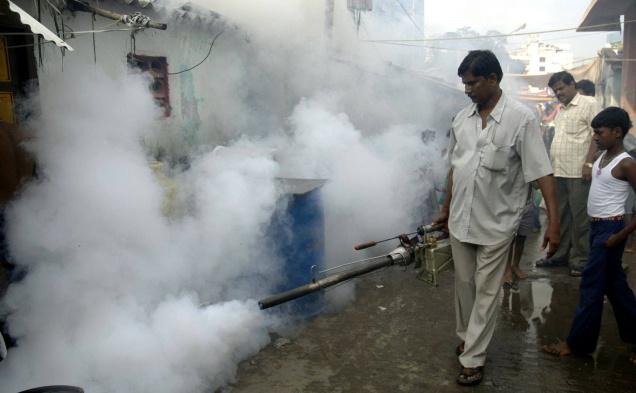The World Health Organisation has recently released the top ten threats to global health that will require immediate and effective attention. Most of these threats have the potential to cause substantial morbidity and mortality. I evaluate how India fares on each of these.
Air pollution and climate change
In 2019, air pollution is considered by WHO as the greatest environmental risk to health. Microscopic pollutants in the air can penetrate respiratory and circulatory systems, damaging the lungs, heart and brain, killing 7 million people prematurely every year from diseases such as cancer, stroke, heart and lung disease.
India fares particularly poorly in this regard. According to the Global Burden of Disease Report 620,000 premature deaths occur in India from air pollution-related diseases each year. Of the ten most polluted cities in the world, nine are in India. Public health experts say that breathing in these cities is equivalent of smoking 50 cigarettes per day. India needs to recognize quickly that this fast and urgent crisis will need immediate redressal.
Non communicable diseases
WHO estimates that non-communicable diseases, such as diabetes, cancer and heart disease, are collectively responsible for over 70% of all deaths worldwide, or 41 million people. This includes 15 million people dying prematurely, aged between 30 and 69.
India’s burden of non-communicable diseases (NCDs) is escalating. Nearly 61% of deaths in India are now attributed to non-communicable diseases, including heart disorders, cancer and diabetes. Four risk factors responsible are tobacco, unhealthy diet, physical inactivity and harmful use of alcohol. All four factors are on the rise in India. The government has a programme called the National Program for Prevention and Control of Cancer, Diabetes, CVD and Stroke (NPCDCS) that aims to promote activities related to health promotion, early diagnosis, treatment and referral, and further facilitate partnership with laboratories for early diagnosis in the private sector. Greater awareness and information campaigns among the public are needed for controlling the rise of NCDs.
Global Influenza Pandemic
WHO predicts that the world will face another influenza pandemic is constantly monitoring the circulation of influenza viruses to detect potential pandemic strains: 153 institutions in 114 countries are involved in global surveillance and response. Every year, WHO recommends which strains should be included in the flu vaccine to protect people from seasonal flu.
Flu is a serious threat for a country like India where population is dense and transmission can be rapid. In fact, this year swine flu epidemic has killed 160 in India and around 4571 people have been tested positive for the disease. This is different from influenza that continues to cause high mortality and morbidity, particularly in children, elderly and immune suppressed. Vaccines in the form of flu shot are available for both but are still not a part of government health programme. Prevention is possible through better hand washing and hygiene.
Fragile and vulnerable settings
More than 1.6 billion people (22% of the global population) live in places where protracted crises (through a combination of challenges such as drought, famine, conflict, and population displacement) and weak health services leave them without access to basic care.
This is especially true for India. Tribal health in India continues to show poor indicators and faces neglect, as tribals are often geographically isolated – living in dense forests or mountainous terrains and are excluded from accessing health services. India’s migrant population, especially those in urban areas, living in makeshift slums are unable to access health care or clean water. They are also vulnerable to drug related morbidities and infectious diseases. While India’s disaster response after floods or droughts has been effective, aftermath of these natural calamities exposes a large population to infections and injuries. India also has a substantial population of refuges in border states that continue to be extremely vulnerable in terms of health.
Antimicrobial resistance
WHO states that antimicrobial resistance – the ability of bacteria, parasites, viruses and fungi to resist these medicines – threatens to send us back to a time when we were unable to easily treat infections such as pneumonia, tuberculosis, gonorrhoea, and salmonellosis. This is perhaps one of the biggest emerging global threat. Overuse of antibiotics is leading to drug resistant strains and has been especially dangerous for diseases like tuberculosis.
India has fared particularly poorly in this regard. Antibiotics in India are over prescribed and even available over the counter without prescription. Moreover many do not complete the required course and leave the medicine mid way as soon as they start feeling better. India has witnessed an increase in antibiotic consumption — about 65 per cent in 2015 compared to 2000, while the rate of consumption increased from 3.2 to 6.5 billion daily defined doses (DDDs) in the same period. Doctors in AIIMS point out that antibiotic resistance has worsened in the last decade, rendering most antibiotics obsolete. Due to this more babies are struck with neonatal sepsis, a series of blood stream infections, within the first month of birth in India than anywhere else in the world. Several of them die due to failure of antibiotics against lethal bugs.
Ebola and other high-threat pathogens
WHO’s R&D Blueprint identifies diseases and pathogens that have potential to cause a public health emergency but lack effective treatments and vaccines. This watchlist for priority research and development includes Ebola, several other haemorrhagic fevers, Zika, Nipah, Middle East respiratory syndrome coronavirus (MERS-CoV) and Severe Acute Respiratory Syndrome (SARS) and disease X, which represents the need to prepare for an unknown pathogen that could cause a serious epidemic.
India faced Nipah threat this year in the state of Kerala. It was quickly contained but more than 10 people lost their lives to the disease. Later last year India struggled with a significant Zika outbreak mostly in the state of Rajasthan. India has a high population density, poor vector control measures (evidenced by high dengue and malaria cases every year following monsoons) and in most cases still lacks highly equipped surveillance and monitoring systems.
Weak primary health care
In October 2018, WHO co-hosted a major global conference in Astana, Kazakhstan at which all countries committed to renew the commitment to primary health care made in the Alma-Ata declaration in 1978.
India’s primary health care system in the form or National Health Mission although extensive and comprehensive, struggles to cater to large population. Maternal and child health, immunisations, and access to basic medicines has increased yet a large section of population continues to spend out of pocket for accessing basic health services due to lack of access. One of the main criticisms of Ayushman Bharat has been that the infrastructure required to cater to such a scheme is simply absent.
Vaccine hesitancy
Vaccine hesitancy – the reluctance or refusal to vaccinate despite the availability of vaccines – threatens to reverse progress made in tackling vaccine-preventable diseases. As a result of misinformation and complacency, infectious diseases that had been almost non-existent are making a comeback.
India has historically been at the forefront of making basic childhood vaccines a priority public health goal. India saw an extensive campaign to eradicate polio with an enthused health force. The campaign saw much advocacy to dispel rumours. Immunization coverage of UIP vaccines has also increased – according to the latest NFHS-4 survey, 62 percent of children age 12-23 months had received all basic vaccinations at any time before the survey, and 54 percent received all basic vaccinations by age of 12 months – albeit it remains far from universal. Lower coverage in India is usually not due to vaccine hesitancy but due to lack of access and information. However, some hesitancy has come recently from the government’s side in introducing new vaccines like the HPV vaccine.
Dengue
Dengue, a mosquito-borne disease that causes flu-like symptoms and can be lethal and kill up to 20% of those with severe dengue, has been a growing threat for decades. Even WHO has noted India to be one of the highly endemic countries for dengue during and after the monsoons.
Dengue cases in India also prove to be fatal. Urban living conditions, stagnant water, poor sanitation, high density, construction activities and poor urban waste management systems make India a hotbed for mosquito breeding every year. A vaccine for dengue is available but has not yet been introduced in India.
HIV
The epidemic continues to rage with nearly a million people every year dying of HIV/AIDS. Today, around 37 million worldwide live with HIV. Moreover stigma still surrounds the disease making awareness and treatment difficult.
HIV prevalence in India is low (0.2%) however high population in India means 2.1 million people in India are living with HIV. National AIDS Control Programme has made efforts to reach key affected populations like sex workers or men who have sex with men. More than half of the affected adults are on antiretroviral treatment that is free, yet access is low as many face difficulty in accessing clinics.


















